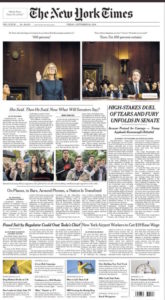September marked one of the most bitterly divisive months in recent US political history. And that’s saying something.
Now that Brett Kavanaugh has been officially sworn in as the ninth justice on the Supreme Court, America is turning its attention to its next landmark political battle, the midterm elections on November 6th. And the events of the past few weeks – particularly the final days of Kavanaugh’s confirmation process – will undoubtedly have significant consequences for the remaining month of campaigning.
Republicans and Democrats are vying for control of Congress, with each party confidently speaking about a red or blue “wave” respectively. And the stakes are high.
But while Americans love to argue about elections, they are often less enthusiastic about showing up to vote in them. Historically, midterm elections witness much lower voter turnout compared to presidential elections, but 2018 has been an unprecedented year for voter participation, particularly for the Democrats. A Pew Research poll found that while the voter turnout during this year’s primary election season had increased for both Democrats and Republicans, it was the former that was seeing more substantial gains.
“While turnout rates rose this year in both Democratic and Republican House primaries, the increase was greater on the Democratic side – up 4.6 percentage points, to 10.8% of all registered voters, versus a 1.2-point increase (to 8.7%) on the Republican side.”
This surge in voter participation is the result of increased awareness and concern for debates around policy issues such as immigration and healthcare. Yet Hillary Clinton’s defeat to Donald Trump in 2016 and the emergence of the #MeToo movement in 2017 has fueled the role of gender politics in America ever since. With an historic number of women running for office in this election cycle, the momentum for most of this year was with the Democrats and was contributing to comfortable leads in the polls over Republicans.
Then came Brett Kavanaugh.
 The accusations of sexual assault against the president’s nominee to the highest court were initially widely seen as giving Democrats a boost heading into the November elections. The overwhelming support for Dr Christine Blasey Ford following her passionate testimony to the Senate Judiciary Committee ignited female empathy and enthusiasm. Speaking to NBC News, Neera Tanden, the president of the Center for American Progress, a liberal think tank, said: “The women of this country identify with Dr Ford and will not forget what is happening here. They are not angry, they are furious, and I expect the largest women’s turnout in a midterm — ever.”
The accusations of sexual assault against the president’s nominee to the highest court were initially widely seen as giving Democrats a boost heading into the November elections. The overwhelming support for Dr Christine Blasey Ford following her passionate testimony to the Senate Judiciary Committee ignited female empathy and enthusiasm. Speaking to NBC News, Neera Tanden, the president of the Center for American Progress, a liberal think tank, said: “The women of this country identify with Dr Ford and will not forget what is happening here. They are not angry, they are furious, and I expect the largest women’s turnout in a midterm — ever.”
But after an intense campaign by Kavanaugh’s supporters – and his own testimony to the committee – to paint him as the victim and those protesting against him as a “mob”, the polling gap between Democrats and Republicans has largely evaporated. In July a NPR/PBS NewsHour/Marist poll showed that 78% of Democrats and 68% of Republicans said that the midterm elections in November were “very important.” As of October, the same poll now has 80% of Democrats and 78% of Republicans claiming that this election is “very important.” NPR reported following the publication of the October polling that “the wide Democratic enthusiasm advantage that has defined the 2018 campaign up to this point has disappeared”.
Axios called this “The Brett Bounce”, citing GOP strategists claiming there was a broad surge in support from Republicans for Kavanaugh and, by extension, the president and the party. Emma Green, a reporter for The Atlantic, interviewed a number of female GOP leaders across America who said they were incensed by the way in which Kavanaugh was treated by Democrats during the confirmation process. This helps put some flesh on the latest NPR/PBS NewsHour/Marist poll.
But as Maggie Haberman of the New York Times pointed out on Twitter, 4 weeks in US politics these days is a very long time and the enthusiasm for Kavanaugh on the right may not last as long as the anger on the left.
While Democrats are expected make gains in the House of Representatives and possibly take back control of the lower chamber, the controversy surrounding the Kavanaugh confirmation is likely to benefit Republicans in the Senate. The issue plays out differently state-by-state and each electorate’s attitudes towards issues such as sexual misconduct and women’s reproductive rights.
While states such as Florida and New Jersey are in play for Democrats, there are strong indications that they will lose seats in key Republican strongholds such as Montana, Missouri, Indiana, North Dakota and West Virginia. While Democrat Joe Manchin of West Virginia voted in favour of Kavanaugh’s confirmation, each of his Democratic colleagues in the other competitive states voted “no”.
It remains to be seen to what extent the contests will be determined by the fallout from Kavanaugh’s confirmation, or by support for President Trump’s broader agenda.
Bench Press
Forty-five per cent of Americans think the media were biased against Kavanaugh, adds Steve McGookin. And in Trumpworld, perceptions are – almost – everything.
The partisan victory lap that was Monday night’s swearing-in ceremony was carried live on all the US TV networks, whose audiences got to witness the president apologize to the new Justice for the “terrible pain and suffering you have been forced to endure,” before triumphantly – and erroneously – pronouncing him “innocent”. Matt Ford at The New Republic called Kavanaugh’s appointment to the bench “the point of no return.”
In what Axios’s Jim VandeHei calls America, the radicalized, virtually every one of the nation’s institutions are being reshaped by the political polarization that characterizes the public discourse. And the media are no exception.
“The cable news networks are racking up record ratings around the sideshow of politics,” VandeHei writes. “Reporters, who previously kept their personal views private, suddenly pick sides on Twitter. Since the president’s election, reporters on both sides of the political aisle, and from markets big and small, have shown less restraint on social media when it comes to their personal political viewpoints.”
ABC’s Matthew Dowd tweeted about why a state of almost perpetual grievance and victimhood continued on the right when they “hold all the levers of power.” In part, it’s because there needs to be two sides for the media spectator sport that is political television. With the midterms looming, it’s important to keep the base engaged and motivated – hence the president’s series of campaign rallies this week (although interestingly even Fox News is no longer carrying them live) – and, crucially, it also helps with fundraising. Both parties reported a surge in donations during the Kavanaugh episode, and on both sides the red-meat narrative is expected to persist, at least in the background, between now and election day.
 In the run-up to the Republicans’ confirmation “victory” mainstream media big guns were rolled out in a co-ordinated formation that likely bore the strategic imprint of former Fox co-president Bill Shine, who now directs communications for the White House. From the interview on Fox with Kavanaugh and his wife – described as the equivalent of his ‘Checkers’ speech – and its coverage in the next day’s New York Post, to his op-ed in the Wall Street Journal and finally, that same paper’s controversial headline after Sen Susan Collins finally told the Senate she was voting yes.
In the run-up to the Republicans’ confirmation “victory” mainstream media big guns were rolled out in a co-ordinated formation that likely bore the strategic imprint of former Fox co-president Bill Shine, who now directs communications for the White House. From the interview on Fox with Kavanaugh and his wife – described as the equivalent of his ‘Checkers’ speech – and its coverage in the next day’s New York Post, to his op-ed in the Wall Street Journal and finally, that same paper’s controversial headline after Sen Susan Collins finally told the Senate she was voting yes.
But while echoes of the Kavanaugh appointment will certainly continue to resonate, with every day that passes there are seemingly endless distractions – some, like Nikki Haley’s departure premeditated and intriguing, others like the potentially catastrophic Hurricane Michael an uncontrollable force of nature, and a story that reminds us of the plight of Puerto Rico. There are also tragic, unexpected stories like the disappearance of Saudi journalist Jamal Khashoggi.
The sheer pace of the news cycle makes it all the harder to focus on some of the remarkable in-depth reporting that we’ve seen in recent days and weeks.
The New York Times epic investigation into the Trump family tax schemes, for example, or the paper’s previous deep dive into the Russia story, “the plot to subvert an election”. Both already seem old news.
Jack Shafer at Politico wrote on the tax revelations that the story suffered because it was so huge and “so exclusively exclusive” to the Times. He writes: “No paper had anything close to what the Times had on the tax story, so Times competitors couldn’t immediately chase the tax scoop to create the updraft of coverage that distributes a topic into the high ether for all comers to inhale.”
Then there’s the reporting by the Associated Press about the ongoing separation of migrant children from their parents and their possible adoption by American families. This story will continue to rumble, even if it no longer commands as high a profile as it did just a few weeks ago.
Even when longer-running scandals surrounding the president appear to merge together, as David Corn wrote this summer at Mother Jones, he’ll simply tweet “Witch Hunt” and the show moves on. “These revelations do not emerge in chronological or thematic order,” Corn says. “They arrive as part of the fusillade known as the daily news cycle… The problem is there is no organized force with as loud a bullhorn countering his disinformation in fundamental terms.”
And while the media has a symbiotic relationship with the president, it’s hard to see how anything changes.
In a remarkable signed op-ed on Wednesday in USAToday, president Trump fulminated, as if at one of his rallies, against the prospect of a win for the Democrats in November, saying the party wanted to “model our economy after Venezuela” and that they would bring America closer to socialism and “suffering, misery and decay”. According to The Guardian, the article “has echoes of Trump’s shocking 2017 inauguration speech, which employed dystopian language and a bleak appraisal of the country as blighted in a state of “American carnage.”
As CNN and others wondered, when the president says it, does that mean it’s automatically worth publishing?
With November approaching, and 2020 on the horizon beyond, the political “frenzy” on our screens, computers and cellphones – as well as in our newspapers, magazines, even childrens’ books – is more frenzied than ever.
The next four weeks are going to generate plenty of noise; but they will also make for plenty of must-see, must-read, must-Tweet content. And both sides of the media equation probably wouldn’t have it any other way.
